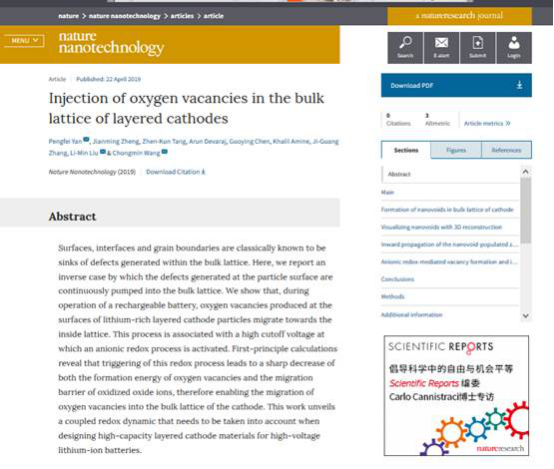Beijing, Apr. 22 -Nature Nanotechnologyhas published the research results in the field of layered metal oxides online, titled “Injection of oxygen vacancies in the bulk lattice of layered cathodes”. Through experiments and theoretical calculations, the article presents that the diffusion and activation of oxygen ions in layered oxidation material is easier than previously realized.
Professor Liu Limin from the School of Physics of Beihang University, Professor Wang Chongming of the Pacific Northwest National Laboratory (PNNL), Professor Yan Pengfei of Beijing University of Technology and other scholars have worked together to make the research achievements through the combination of Transmission Electron Microscopic and first-principles calculations. The research is funded by the National Natural Science Foundation of China, the Newton Advanced Fellowship, the Challenge Program, and the Top-Notch Youth Talents Project of Beihang, etc.

With high energy density, layered oxide cathode materials are expected to replace the current commercialized cathode materials and to achieve the breakthrough in the energy storage properties of lithium ion batteries. The high capacity of the lithium-rich layered cathode material is derived from its redox activation of oxygen ions during the process of charge and discharge, instead of simply using transition metals as redox particles. This process is associated with a high cutoff voltage at which the redox process of oxygen ions is activated, and therefore, the triggering of this redox process often leads to serious degradation on material interface, in which the material interface degradation caused by the phase transition on the material surface is a very important degradation mechanism. This study finds that the diffusion of oxygen in layered oxides is much easier than previously imagined. The diffusion and loss of oxygen ions during battery cycling leads to the formation of a large number of nano-sized bubbles inside the material, triggering the phase transformation of the crystal structure of the material at the same time. This mechanism deepens the understanding of the generation and diffusion rules of oxygen ions in layered metal oxides, and provides an important research basis for optimizing the stability of lithium ion battery cathode materials.
Professor Liu Limin has published a series of research theses in the field of metal oxide defects since September 2017, when he joined the School of Physics of Beihang University. He has published five papers inNature’s sub-journals as corresponding author, with one inNature Nanotechnology, one inNature Phonicsand three inNature Communications. His research work has received widespread attention. Invited bySurface Science Reportsin 2018, he wrote a review paper titled “Excess electrons in reduced rutile and anatase TiO2” (Surf. Sci. Rep. 73, 58 (2018)).
The research article is available at:
https://www.nature.com/articles/s41565-019-0428-8